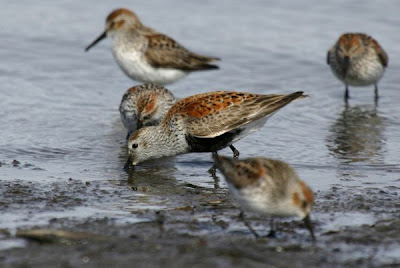Being used to birding in areas where eastern kingbirds are plentiful, I would not normally consider them a highlight of a birding trip in late August. However, when there are thirty of them, all sitting in the same tree, it is a different story.
This morning I took a birding walk in Higbee's Beach WMA. I did not join the Morning Flight Project but instead wandered the trails. There was a constant stream of birds going north when I first got there. Most of the birds went by me unidentified; the ones I did identify were mostly either kingbirds or barn swallows.
There were a few patches of activity in the path edges. I saw several Empidonax flycatchers, one of which I think was a least, in addition to the kingbirds mentioned above. Elsewhere a white-eyed vireo was singing out of a dense tangle (or at least something was singing a white-eyed vireo song). There were a few patches of warblers, but not a lot of diversity. One patch held American redstarts, black-and-white, and black-throated blue warblers. Elsewhere were common yellowthroats and an ovenbird.
It was a good introduction to birding at Higbee's Beach. I am not yet sure how much time I will be able to spend there this fall, but it would be worth a trip back.
One complaint: David Sibley's Birds of Cape May encourages birders to cycle to Higbee's rather than driving. The trouble is, there are not any bicycle racks around the parking lots – or at least none that I saw. Pretty much the only places to lock a bicycle securely are the loops in the guardrails. Given that every other site I have visited around Cape May is so bicycle-friendly, it seems a strange omission.





















